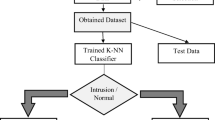Abstract
In recent years, the Internet of Things has grown visibly and soon will be an essential part of our daily lives. This increases the number of transactions in a network and with that risks to these sensitive data increase too; thus, we require a smart system to detect any unauthorized advances to an IoT network and prevent those risks. This system predicts and delivers possibilities of the intrusion based on a few attributes identified using feature engineering. An Intrusion Detection System is tested on its ability to detect malicious activities within IoT networks. Here, we propose an Anomaly-based Intrusion Detection System that detects and prevents attacks on the IoT environment. This approach has two primary objectives to address. First, the data require filtration using the correlation coefficient to combine the probability of distribution to identify features that have a positive impact on the accuracy. Second, the classifier algorithm identifies the behavior using the trust factor based on the selected features. In this step, we analyze the precision, recall, and f1-score of the model on a pre-existing NSL-KDD dataset where the proposed model obtained 98.4% accuracy along with high TPR (True-Positive Rate) and low FPR (False-Positive Rate).


Similar content being viewed by others
References
Singh KP, Tomar S, Jain U, Hussain M. Simplified and secure session key sharing for the Internet of Things (IoT) networks. In: International conference on internet of things and connected technologies. Berlin: Springer; 2020. p. 319–32.
Kumar A, Lim TJ. EDIMA: early detection of IoT malware network activity using machine learning techniques. IEEE World Forum Internet of Things (WF-IoT). 2019. https://doi.org/10.1109/WF-IoT.2019.8767194.
Chang H, Feng J, Chaofan D. HADIoT: a hierarchical anomaly detection framework for IoT. IEEE Access. 2020. https://doi.org/10.1109/ACCESS.2020.3017763.
Depren O, Topallar M, Anarim E, Ciliz MK. An intelligent intrusion detection system (IDS) for anomaly and misuse detection in computer networks. Expert Syst Appl. 2005;29:713–22. https://doi.org/10.1016/j.eswa.2005.05.002.
Denning DE. An intrusion-detection model. In: IEEE Symposium on Security and Privacy, 1986, pp. 118–131.
Lincoln M. Laboratory, DARPA intrusion detection data sets. 2016. https://www.ll.mit.edu/ideval/data/. Accessed 07 Apr 2016.
McHugh J. Testing intrusion detection systems: a [33] critique of the 1998 and 1999 DARPA intrusion detection system evaluations as performed by Lincoln Laboratory. ACM Trans Inf Syst Secure. 2000;3(4):262–94.
De la Hoz E, De La Hoz E, Ortiz A, Ortega J, Prieto B. PCA filtering and probabilistic SOM for network intrusion detection. Adv Comput Intell. 2015;164:71–81.
Ravale U, Marathe N, Padiya P. Feature selection based hybrid anomaly intrusion detection system using K-means and RBF kernel function. In: Proceeding of international conference on advanced computing technologies and applications, ICACTA-2015, procedia computer science, vol. 45. Amsterdam: Elsevier; 2015. p. 428–35.
Haddadpajouh H, Javidan R, Khayami R, Dehghantanha A, Choo K-KR. A two-layer dimension reduction and two-tier classification model for anomaly-based intrusion detection in IoT backbone networks. IEEE Trans Emerg Top Comput. 2016. https://doi.org/10.1109/TETC.2016.2633228.
Murali S, Jamalipour A. A lightweight intrusion detection for Sybil attack under mobile RPL in the Internet of Things. IEEE Internet Things J. 2019. https://doi.org/10.1109/jiot.2019.2948149.
Altwaijry H, Algarny S. Bayesian-based intrusion detection system. J King Saud Univ Comp Inf Sci. 2012;24:1–6.
Shrivas AK, Dewangan AK. An ensemble model for classification of attacks with feature selection based on KDD99 and NSL-KDD data set. Int J Comput Appl. 2014;99:8–13.
Bhavsar YB, Waghmare KC. Intrusion detection system using data mining technique: support vector machine. Int J Emerg Technol Adv Eng. 2013;3:581–6.
Dhanabal L, Shantharajah SP. A study on NSL-KDD dataset for intrusion detection system based on classification algorithms. Int J Adv Res Comput Commun Eng. 2015;4:446–52.
Wagh SK. Survey on intrusion detection system using machine learning techniques. Int J Comput Appl. 2013;78(16):30–7.
Qiu C, Shan J, Polytechnic B, Shandong B. Research on intrusion detection algorithm based on BP neural. Network. 2015;9(4):247–58.
Vokorokos L, Balaiz A, Chovanec M. Intrusion detection system using self-organizing map. Informatica. 2006;6(1):1–6.
Planquart J-P. "Application of neural networks to intrusion detection". https://rr.sans.org/intrusion/neural.php (2001).
Sahu SK, Sarangi S, Jena SK. A detailed analysis on intrusion detection datasets. In: Souvenir 2014 International Advance Computing Conference IACC, 2014, pp. 1348–1353.
Allen J, Alan C, William F, John M, Jed P. State of the practice of intrusion detection technologies, Technical Report no. CMU/SEI-99-TR-028, Tech. Rep., 2000, p. 221.
Paxson V. Bro: a system for detecting network intruders in real-time. Comput Netw. 1999;31(23):2435–63.
Gajewski M, Batalla J, Mastorakis G, Mavromoustakis C. Anomaly traffic detection and correlation in smart home automation IoT systems. Trans Emerg Telecommun Technol. 2020. https://doi.org/10.1002/ett.4053.
Tavallaee M, Bagheri E, Lu W, Ghorbani AA. A detailed analysis of the kdd cup 99 data set. In: Proceedings of the Second IEEE international conference on computational intelligence for security and defense apps. Piscataway: IEEE Press; 2009. p. 53–8.
Choudhary S, Kesswani N. Analysis of KDD-Cup’99, NSL-KDD and UNSW-NB15 datasets using deep learning in IoT. Proced Comput Sci. 2020;167:1561–73. https://doi.org/10.1016/j.procs.2020.03.367.
Author information
Authors and Affiliations
Corresponding author
Ethics declarations
Conflict of Interest
On behalf of all authors, the corresponding author states that there is no conflict of interest.
Additional information
Publisher's Note
Springer Nature remains neutral with regard to jurisdictional claims in published maps and institutional affiliations.
This article is part of the topical collection “Enabling Innovative Computational Intelligence Technologies for IOT” guest edited by Omer Rana, Rajiv Misra, Alexander Pfeiffer, Luigi Troiano, and Nishtha Kesswani.
Rights and permissions
About this article
Cite this article
Singh, K.P., Kesswani, N. An Anomaly-Based Intrusion Detection System for IoT Networks Using Trust Factor. SN COMPUT. SCI. 3, 168 (2022). https://doi.org/10.1007/s42979-022-01053-9
Received:
Accepted:
Published:
DOI: https://doi.org/10.1007/s42979-022-01053-9




